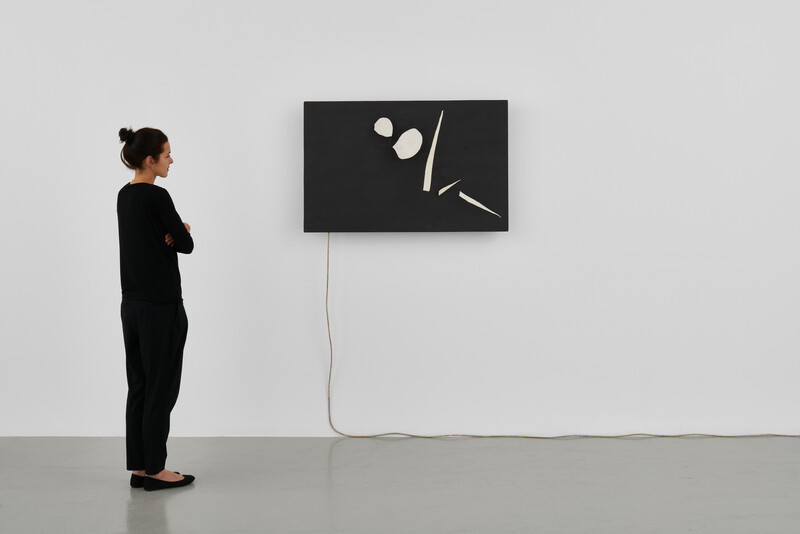Essays
Jean Tinguely
by Viola McGowan

Jean Tinguely, Stabilité N°5., 1959 © The Estate of Jean Tinguely. Photo: Jon Etter
- 1 January 2019
‘We are all still very much annoyed by out-of-date notions of time. Please, would you throw away your watches! At least, toss aside the minutes and hours. Obviously, we all realize that we are not everlasting. Our fear of death has inspired the creation of beautiful works of art. And this was a fine thing, too. We would so much like to own, think or be something static, eternal, and permanent. However, our only eternal possession will’
The above decree, an excerpt from Jean Tinguely’s ‘For Static’ lecture at the Institute of Contemporary Arts, London, in 1959, exemplifies the artist’s general adherence to the Heraclitian axiom that change is the only constant in life. He would later clarify, ‘Movement is static because it is the only immutable thing—the only certainty, the only ’[2] This ethos is visible in Tinguely’s ‘Stabilité No. 5’ (1959) from his Relief series, a body of work characterized by kinetic sheet metal forms mounted on rods and set into a monochromatic plywood background that conceals a connected system of pulleys, cogwheels, and rubber belts, activated by a small motor. Here, in ‘Stabilité No. 5’, five white irregular cut-out shapes appear to hover over a black box-frame support, recalling the biomorphic woodcut forms of Jean Arp’s Constellation Reliefs.
In addition to the formal similarities between Arp and Tinguely’s relief works, Tinguely adopted Arp’s incorporation of chance and spontaneity as elements of his process. And just as Arp’s reliefs demonstrate constellational counterpoints between varying forms, so too does Tinguely’s ‘Stabilité No. 5’. Although we find the elements fixed in rotation like dials, the various speeds assigned to each element as well as the possibility of the work’s vertical or horizontal orientation generate countless formal variables as to impede the same configuration from reoccurring. As Tinguely once proclaimed, ‘It would take at least 10,000 years for this extraordinary new machine to repeat before our eyes the same’.[3] In this way, the work becomes a fluid, ongoing system of self-disruption.

Jean Tinguely, Stabilité N°5., 1959 © The Estate of Jean Tinguely. Photo: Jon Etter
Presaging the ‘change or die’ attitude that pervades contemporary technoscience, wherein the rapid disruption and subsequent obsolescence of a technological design is synonymous with advancement, the use of mechanical means to embody a perpetual state of reconstruction preoccupied Tinguely. Influenced by Dadaism, and more specifically Marcel Duchamp, Tinguely advanced Dadaist philosophy to reconsider the role of chance in the act of creation, not as a static display of something that had come about by chance but ‘chance in ’[4] From 1954 through 1959, Tinguely produced large reliefs such as Meta-Kandinsky (1956) based on neo-plastic paintings, and Meta-Malevich (1954), based on Suprematist monochromes, juxtaposing stationary and mobile shapes.
The latter was a particularly vital source for the artist, in addition to clear references in his white-on-white reliefs, his influence also led to a series of 20 black and white eponymously titled Meta-Malevich reliefs. In this way, Tinguely’s meta-production engages with the spatiotemporal dynamic of variation through repetition, a conceptual framework thoroughly examined by his Italian contemporary, Piero Manzoni, whose series of white Achromes (equally inspired by Malevich) are indexical of infinity through the act of repetitive production within gridded surfaces.
The artist discovered an ‘almost inexhaustible source—a mechanism whose goal was not precision but anti-precision, to mechanics of chance’.
Tinguely’s foundational interest in abstraction and movement developed in his youth. While studying at the Vocational School in Basel under German painter Julia Ris, he was introduced to Dada, the Bauhaus, as well as artists connected to Surrealism, Constructivism, and Suprematism. After relocating to Paris in 1952, settling in an artist colony of 15 studios in the Impasse Ronsin, Tinguely began honing his concepts based on a break from pre-established convictions of pictorial space. The static nature of composition was mobilized and released, materializing in ‘meta-mechanical sculptures,’ a term coined by art historian Pontus Hultén to signify the act of reference and expansion.
Through this, as Hultén observed, the artist discovered an ‘almost inexhaustible source—a mechanism whose goal was not precision but anti-precision, to mechanics of chance’.[5] Although there were clear antecedents to Tinguely’s practice, the interest in generating movement through kinetic art and Op art had been stirring throughout the 1950s, especially in Paris. In 1955, Tinguely, Hultén, and Robert Breer organized ‘Le Mouvement’, an exhibition devoted to this dynamic art form. Held at Galerie Denise René, the show was curated in three parts, the first two consisting of a historical section with mobiles by Marcel Duchamp and Alexander Calder, followed by paintings on layered glass by Victor Vasarely.
The third part of the exhibition focused on works by four young artists, which, in addition to Tinguely, included Yaacov Agam, Pol Bury, and Jesús Rafael Soto—whose optic art was simultaneously activated and dematerialized upon the viewer’s perception while in motion. This was the first time since the end of the war that a new medium other than traditional painting and sculpture had been presented in Paris and the exhibition’s enthusiastic reception reflected the new innovative outlook it projected. As with Tinguely’s ‘Stabilité No. 5’ and the artist’s ensuing output, the exhibition proposed a new universal dynamic in art, at once joyful and deliberately bewildering, teasing, and aggressive, a complex example of mutability and spontaneity to marvel. – Jean Tinguely’s ‘Stabilité No. 5’ will be included in Hauser & Wirth’s presentation at Art Basel 13 – 16 June 2019.

[1] Tinguely quoted in Machines de Tinguely (Paris/FR: Centre national d'art contemporain, 1971), n.p.[2] Tinguely quoted in Calvin Tomkins, “Beyond the Machine,” The New Yorker, 10 February 1962, 65-66.[3] Museum Tinguely, Collection, Meta-Malevich, https://www.tinguely.ch/en/sammlung[4] Pontus Hultén, A Magic Stronger than Death (Milan/IT, Bompiani, 1987), 16.[5] Ibid.
